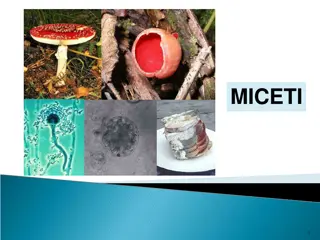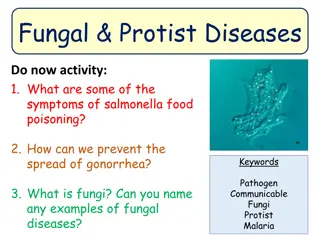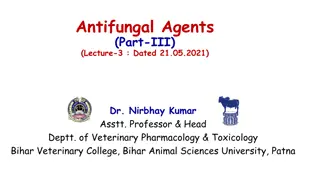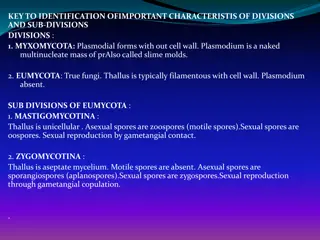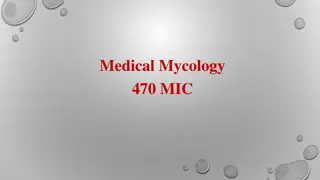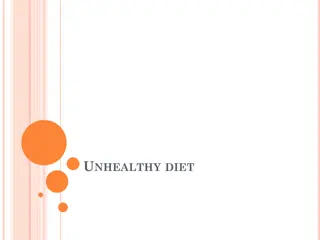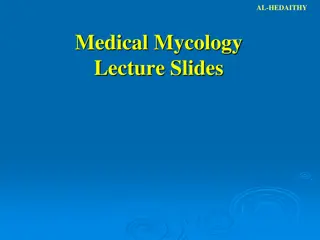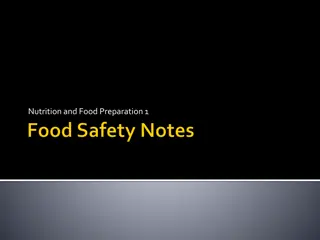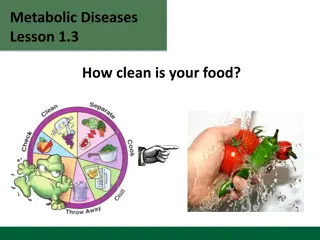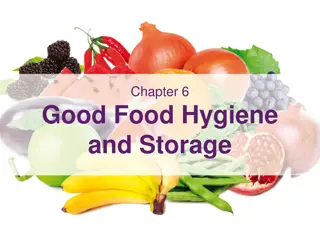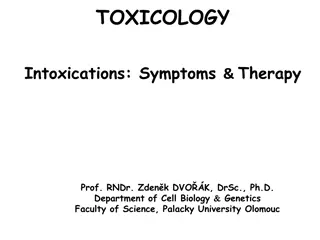Fungal and Chemical Food-Borne Intoxications
Fungal intoxications are caused by mycotoxins produced by fungi in improperly stored food, with aflatoxicosis being a significant concern. Aflatoxins can lead to acute hemorrhagic syndromes and long-term liver tumors. Prevention strategies include proper drying and storage of foods. Chemical food-borne intoxication involves substances like heavy metals, pesticides, and fungicides entering the food chain, posing health risks if consumed. Vigilance in food production, processing, and storage is essential to prevent these toxic exposures.
Download Presentation

Please find below an Image/Link to download the presentation.
The content on the website is provided AS IS for your information and personal use only. It may not be sold, licensed, or shared on other websites without obtaining consent from the author.If you encounter any issues during the download, it is possible that the publisher has removed the file from their server.
You are allowed to download the files provided on this website for personal or commercial use, subject to the condition that they are used lawfully. All files are the property of their respective owners.
The content on the website is provided AS IS for your information and personal use only. It may not be sold, licensed, or shared on other websites without obtaining consent from the author.
E N D
Presentation Transcript
Food Borne Diseases Part 5
Fungal intoxications These are caused by consumption of metabolites produced by fungi, when growing in food. These metabolites are called mycotoxins. Grains, oilseeds, fruits and vegetables are mostly involved if they are stored at high humidity ( 0.75) or if they are not properly dried before storage. Poor dry storage practices of grains and other foods leads to mould growth and production of mycotoxins. Of significance to public health is aflatoxicosis.
Aflatoxicosis Aflatoxicosis is caused by aflatoxins produced by the fungi, e.g. Aspergillus flavus. Four types of aflatoxins have been described i.e. aflatoxin B1, B2, G1and G2.
Effects of aflatoxins When consumed in large doses, they are lethal in causing acute hemorrhagic syndromes Sub-lethal doses cause histotoxic changes Long term consumption of small doses cause liver tumors as these are potent carcinogens.
Prevention of aflatoxicosis Proper drying and storage of grains and other affected foods Quality control of potentially hazardous foods to ensure that they do not contain above the allowable limits of 20 ppb(parts per billion) before consumption by use of appropriate analytical tests. Use of fungicides as seed dressings to protect stored cereals and other foods like pulses and potatoes against fungal invasion.
CHEMICAL FOODBORNE INTOXICATION This is a type of food borne intoxication arising from consumption of food containing poisonous chemicals, These may be intentionally or unintentionally added to foods as a result of producing, processing, transporting or storage. A number of substances can enter the food chain from the environment and through their use as growth promoters or veterinary therapeutics giving rise to chemical residues.
Chemical substances involved Chemical food borne intoxication involve the following substances: Heavy metals e.g. antimony, mercury, arsenic, flouride, lead, cadmium, cyanide etc. Pesticides and insecticides e.g. DDT, BHC Organochlorines and organophosphates. Herbicides Fungicides e.g. organomercurials
Chemical substances involved.. Preservatives e.g. nitrites, nicotinate, etc Antibiotics e.g. pencillin, tetracyclines, chloramphenicol etc. Radionuclides e.g. cesium, strontium, radium, molybdenum, barium, ruthenium, lanthanum, iodine isotopes etc.
How chemicals enter foods Accidental contamination by Heavy metals, Pesticides, and radionuclides. Intentional addition e.g preservatives such as nitrite and sodium nicotinate for color preservation and fungicides used as dressing during storage. Leaching from containers e.g zinc galvanized containers by acid foods, copper surfaces, lead pipes, asbestos roofs. Usage: Presence of such chemicals in food as a result of use of their use in animal and crop husbandry Maliciously added to cause harm (is rare).
Clinical signs and symptoms Chemical food borne intoxication exhibit a very short incubation period, usually a few minutes to a few hours, with an average of one hour. Symptoms are mainly due to effect on gastrointestinal tract and central nervous system and include nausea, headache, convulsions, gastrointestinal irritation, abdominal cramps, vomiting and diarrhea, pallor, cyanosis, blurred vision, sweating, and collapse. Other signs may be due to effects on circulatory system. Symptoms of radionuclide toxicity depend on dose, time and organ affected.
Preventive measures Do not use utensils or containers that are able to leach chemicals such as antimony, cadmium, zinc, copper, etc. Use of coloured pesticides and proper storage of the same. Prevent contamination of foods when using insecticides. Prevent acid foods or carbonated liquids from contact with exposed copper.
Preventive measures Prevent misuse or avoid use of dangerous additive e.g. sodium nicotinate. Education of persons preparing food (e.g. possibility of Zn poisoning).
Biotoxications These are disorders resulting from ingestion of a poisonous substance (a biotoxin) present in the body of a plant or animal. Such substances are derived from plants or animals presumably as a result of metabolic activities. Only a small proportion of the species of fish and shellfish taken for human consumption throughout the world contain biotoxins.
Animals biotoxications This type of intoxication occurs as a result of consumption of poisonous animals. Animal tissues may be rendered poisonous by bacterial and enzymatic decomposition, but some are naturally toxic. Primary toxicity occurs due to inherent toxicants that arise due to normal metabolic processes,
Animals biotoxications cont.. Secondary toxicity arises due to external toxicants contaminating animal tissues such as pesticides, heavy metals and drug residues. Inherent animal toxins are water soluble and heat labile. High concentrations of these toxins are usually found in viscera and dark meats. Most human poisoning involves secondarily transvectered toxins.
1. Toxic fishes They include puffers, triggerfish and parrot fish. The fish toxin affects the peripheral nervous systems. The fishes may become poisonous by feeding on poisonous marine organisms. A mortality rate of 50% may occur in humans. Types of biotoxications associated with fish include ciguatera poisoning, tetraodon poisoning and scombroid toxicity.
2. Mollusca Mollusca may either be inherently or secondarily toxic. Poisoning is mainly due to the transvection of dinoflagellate protozoa toxins by the mollusca. Mollusca are however not harmed by ingestion of dinoflagellates. Involved toxins are stored in the digestive glands, gills and siphore from where they poison vertebrates Mollusca involved are oysters, mussels and clams, which feed on dinoflagellates and planktons containing alkaloids making them toxic.
3. Poisonous mammals Mammals are not commonly inherently poisonous, but secondary toxicity may affect many of them. The toxin may be of various types e.g. heavy metals, pesticides, toxic plants, therapeutics, fungal or bacterial toxins. Most human poisoning involves secondarily transvectered toxins.
Prevention of animal biotoxications Eating of unknown meats from vertebrates or invertebrates sources is always a threat to the consumer. Local eating customs should be followed and local quarantine regulations strictly adhered to in order to reduce the risk. Avoid sea foods and always heat foods to above 100oC to denature the inherent heat labile toxins that may be present in animal tissues.




